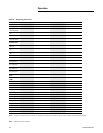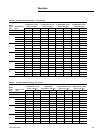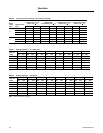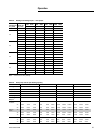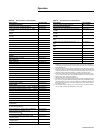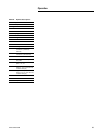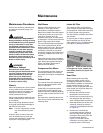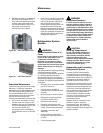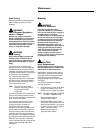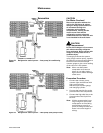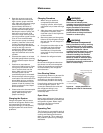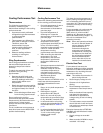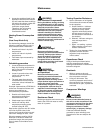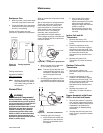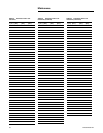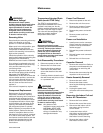
32 PTAC-SVX01C-EN
Maintenance
Leak Testing
Refrigerant leaks are best detected
with a halide or electronic leak
detector.
WARNING
Use of Pressure Regulator –
Valves – Gauges!
Always use pressure regulators,
valves, and gauges to control drum
and line pressures when pressure
testing equipment. Failure to follow
these instructions could result in an
explosion causing death, serious
injury, or equipment damage.
WARNING
Leak Testing!
Do not exceed 200 psig when leak
testing system. Failure to follow
these instructions could result in an
explosion causing death or serious
injury.
The importance of careful leak
testing cannot be over emphasized.
Undetected leaks invariably lead to
repeated calls and eventually result
in system contamination, restrictions
and burned out compressors.
For a system that contains a
refrigerant charge and is suspected
of having a leak, stop the operation,
check all tubing and fittings. Soap
suds may also be used.
Note: The flame of the halide
detector will glow green in
the presence of R22
refrigerant.
If a leak is detected, do not attempt to
apply more brazing material to the
joint. Recover the charge, unbraze the
joint, clean and rebraze.
For a system that has been newly
repaired and does not contain a
charge, connect a cylinder of
refrigerant, through a gauge
manifold, to the process tube of the
compressor and liquid line strainer.
Open the valve on the cylinder and
manifold and allow the pressure to
build up within the system. Check for
and handle leaks as described above.
After the test has been completed,
recover the test charge, evacuate the
system, and recharge with clean
refrigerant.
Brazing
WARNING
Hazard of Explosion!
Use only dry nitrogen with a
pressure regulator for pressurizing
unit. Do not use acetylene, oxygen or
compressed air or mixtures
containing them for pressure testing.
Do not use mixtures of a hydrogen
containing refrigerant and air above
atmospheric pressure for pressure
testing as they may become
flammable and could result in an
explosion. Refrigerant, when used as
a trace gas should only be mixed
with dry nitrogen for pressurizing
units. Failure to follow these
recommendations could result in
death or serious injury or equipment
or property-only damage.
CAUTION
High Temperatures!
Brazing requires high temperatures.
Direct contact with hot surfaces may
cause minor or moderate injury.
Satisfactory brazing results require
cleanliness, experience and the use
of proper material and equipment.
Verify brazing connections are
properly sized, free of rough edges,
and clean.
Use of these generally accepted
brazing materials:
• SIL-FOS (Alloy of 15% silver, 80%
copper, 5% phosphorus): use
without flux on copper to copper.
Note: DO NOT USE FOR A COPPER
TO STEEL CONNECTION.
Recommended heat is
approximately 1400°F.
• SILVER SOLDER (Alloy of 30%
silver, 38% copper, 32% zinc): use
with fluoride base flux on copper
to steel, brass to copper, steel to
steel, or brass to steel.
Recommended heat is
approximately 1200°F.



